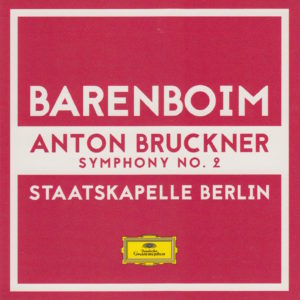
My “office” this morning: Red Hot Inn, a little after 6am. I’m the only person in the restaurant at this hour.
I like it that way.
Red Hot Inn is a local institution. They’re known for their chili dogs. But their breakfasts are quite delicious – and reasonably priced, too.
For the record, I had what they call a “Super Breakfast” (two eggs any style, choice of meat – I choose sausage patties – potatoes, toast, and coffee). All that for under $8.
I guess there are a few good things about living in Grand Rapids.
Anyway…
 This morning, I am listening to Anton Bruckner’s Symphony No. 2 in C Minor (WAB 102), nicknamed “The Symphony of Pauses,” interpreted by Argentine-born pianist and conductor Daniel Barenboim (1942-), whom I saw conduct the Staatskapelle Berlin at Carnegie Hall on January 28th of this year.
This morning, I am listening to Anton Bruckner’s Symphony No. 2 in C Minor (WAB 102), nicknamed “The Symphony of Pauses,” interpreted by Argentine-born pianist and conductor Daniel Barenboim (1942-), whom I saw conduct the Staatskapelle Berlin at Carnegie Hall on January 28th of this year.
The symphony that magical night was Bruckner’s Eighth.
Staatskapelle Berlin is Barenboim’s orchestra for today’s performance, too.
According to its entry on Wikipedia,
The Staatskapelle Berlin is a German symphony orchestra and the resident orchestra of the Berlin State Opera (Berliner Staatsoper Unter den Linden).
The orchestra traces its roots to 1570, when Joachim II Hector, Elector of Brandenburg established the rules for an orchestra at his court which had been constituted, at an unknown date. In 1701, the affiliation of the Electors of Brandenburg to the position of King of Prussia led to the description of the orchestra as “Königlich Preußische Hofkapelle” (Royal Prussian Court Orchestra), which consisted of about 30 musicians. The orchestra became affiliated with the Royal Court Opera, established in 1742 by Frederick the Great. Noted musicians associated with the orchestra have included Carl Philipp Emanuel Bach, Franz Benda, and Johann Joachim Quantz
The first concert by the ensemble for a wider audience outside of the royal courts was on 1 March 1783 at the Hotel Paris, led by Johann Friedrich Reichardt, the ensemble’s Kapellmeister.
NOTE: I have two Barenboim CD box sets for this leg of my Bruckner journey. The first (which I’ll call the “Blue Box”) is on the Warner Classics label. The second (which I’ll call the “Pink Box”) is on the Deutsche Grammophon label. The performances in the Blue Box were recorded in the 1990s. The performances in the Pink Box were recorded much more recently, 2012 and 2010. So…alpha by conductor, then chronological. That’s the plan.
From the entry about Bruckner’s Second on Wikipedia,
Anton Bruckner’s Symphony No. 2 in C minor was completed in 1872, and revised, like most of Bruckner’s other symphonies, at various points thereafter. This work is sometimes known as the “Symphony of Pauses”.
It was composed after the Symphony “No. 0” in D minor (which was itself composed after the Symphony No. 1 in C minor). It is the only “official” Bruckner symphony (that is to say, excluding “No. 0”) without a dedication: Franz Liszt tacitly rejected the dedication, and Richard Wagner chose the Symphony No. 3 in D minor instead. The premiere was given with Bruckner himself conducting in 1873.
And this from a different Wikipedia entry about the Second:
Symphony No. 2 in C minor
The Symphony No. 2 in C minor of 1872 was revised in 1873, 1876, 1877 and 1892. It is sometimes called the Symphony of Pauses for its dramatic use of whole-orchestra rests, which accentuate the form of the piece. In the Carragan edition of the 1872 version, the Scherzo is placed second and the Adagio third. It is in the same key as No. 1.
If you want to know what I thought of Maestro Barenboim’s interpretation of Bruckner’s First (with Staatskapelle Berlin) in this leg of my journey, visit Day 2.
If not, keep reading.
The way this works is I list all the objective stats first. Then, I offer my subjective opinions.
 Bruckner’s Symphony No. 2 in C Minor (WAB 102), composed 1872
Bruckner’s Symphony No. 2 in C Minor (WAB 102), composed 1872
Daniel Barenboim conducts
Barenboim used the “Leopold Nowak Edition, 1965; revised Bornhoft and Carragan, 1997,” according to the CD booklet, the “1877 version,” according to the CD sleeve
Staatskapelle Berlin plays
The symphony clocks in at 54:19
This was recorded in Vienna, Austria at the Musikverein Golden Hall, in June of 2012
Barenboim was 70 when he conducted it
Bruckner was 48 when he finished composing it (the first time)
This recording was released on the Peral Music label (licensed to Deutsche Grammophon)
Bruckner wrote his symphonies in four movements. The time breakdown of this one (Symphony No. 2 in C Minor), from this particular conductor (Barenboim) and this particular orchestra (Staatskapelle Berlin) is as follows:
I. Moderato……………………………………………………………………………………………………..17:23
II. Andante: Feierlich, etwas bewegt (Solemnly, somewhat animated)…………13:03
III. Scherzo: Mäßig schnell (Moderately fast)……………………………………………………7:51
IV. Finale: Ziemlich schnell (Fairly fast)……………………………………………………………16:02
The score calls for a pair each of flutes, oboes, clarinets, bassoons, four horns, two trumpets, three trombones, timpani, and strings.
Total running time: 54:19
According to its entry on Wikipedia about the 1877 version,
1877 version
The editions by Robert Haas (published 1938) and Leopold Nowak (published 1965) are both based on this version.
Haas’ edition contains some features of the previous version, which, as in the 1890 version of the 8th symphony, were crossed out by Bruckner in the 1877 manuscript. The edition by William Carragan (published 1997) is a corrected Nowak edition. Most recordings of the symphony are made of the Haas and Nowak versions. The Carragan edition has been recorded by Daniel Barenboim.
Although the liner notes (written by Detlef Giese) reveal virtually nothing about the character and content of each individual symphony, there is this interesting paragraph about Bruckner’s symphonies as a whole,
The nine symphonies that Bruckner acknowledged in his oeuvre stand before us like a towering mountain range. Unlike those of Beethoven or Mahler, where each work has a unique character and a highly distinct profile, the world of the Bruckner symphonies seems far more unified and self-contained. Each is bound to recurring models in its conceptions and execution. Yet, each is striking enough to reveal essential differences. If homogeneity reigns in their workmanship and sound, a close look can highlight their heterogeneity. Barenboim has summed this up in a nutshell: “When you hear two or three Bruckner symphonies, you hear their similarities. When you hear the complete cycle, you recognize their differences.”
Okay. Now, here are the subjective aspects:
My Rating:
Recording quality: 3
Overall musicianship: 4
CD liner notes: 3 (very thin booklet with a sparse essay about Bruckner, the orchestra, and Barenboim translated into English, German, and French)
How does this make me feel: 3
I don’t like this recording or this performance.
To my ears, this isn’t recorded well – at least, it’s not recorded to my liking.
Which is odd for two reasons:
1. The previous Barenboim-conducted Bruckner Second is a DDD (all-digital) recording. Usually DDD recordings sound dry, brittle. But it doesn’t. That performance (see Day 6) was one of my all-time favorites.
2. This performances is six minutes shorter than the previous Barenboim interpretation. Yet, this one feels longer. It’s a tedious listen for me.
This is purely subjective on my part. But this performance doesn’t feel as magical or inspired as the one did yesterday.
Also, I noticed what sounded like a lot of background noise from about the 7-minute mark in the Finale. Shuffling or something. Almost sounded like rain falling. More hiss than necessary, in other words.
I’m not sure what it is about this recording that doesn’t grab me.
There are a few stand-out performances, however. The Scherzo, for one. It’s a little brassy (loudly recorded brass instruments, in other words). But it’s energetic.
And, of course, I always like the horn and violin pizzicato (the first occurrence is around 2:10) passage of the Andante. I love French horns, anyway. But when combined with the pizzicato, it makes for a fascinating combination.
Yet, French horn is a tough instrument to play. I know from talking to horn players. Plus, my wife used to play French horn. So I know it’s a difficult instrument to play well.
And then there’s the aspect of its tone. The smoothest French horn sound I’ve ever heard is Dennis Brain’s. Smooth as silk.
The horn on the Andante isn’t as smooth as I like them to be. But, with the pizzicato, it’s still noteworthy.
This was a solid performance. Just not an inspired one.
Your mileage may vary.
(So far, the best thing about this CD box set is the discovery of Barenboim’s music label, Peral Music. I bought three books written by Barenboim because of Peral. I’m amazed by Barenboim’s insight and ability to express himself in writing.)
